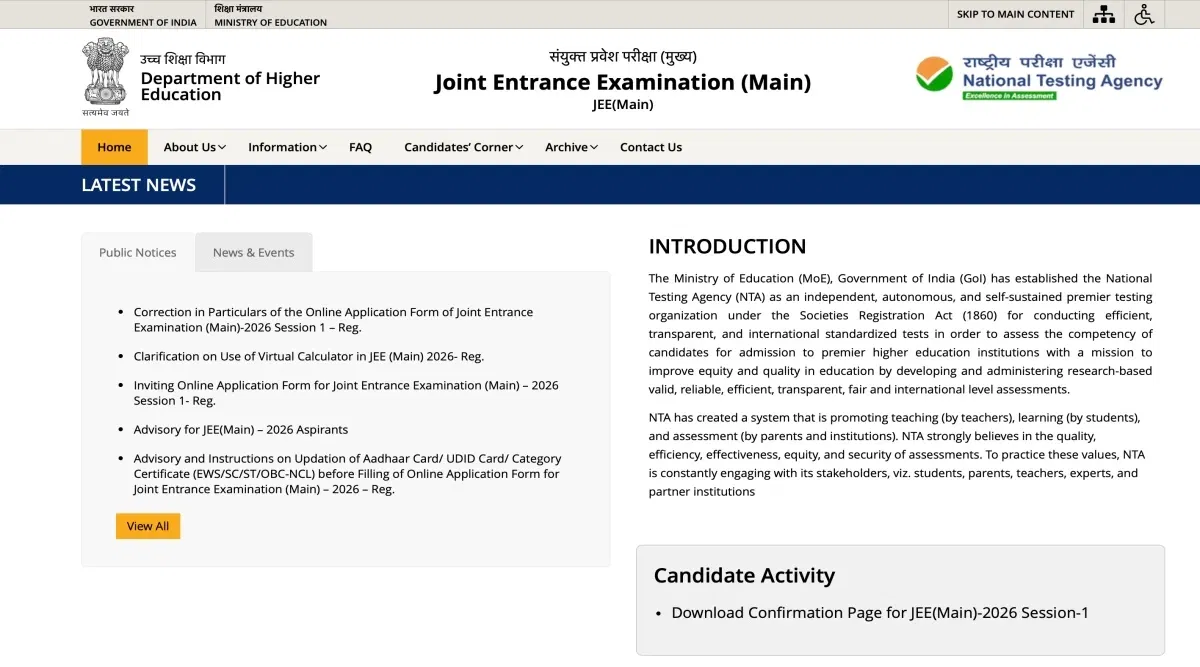CUET Normalization process 2026 is a way to covert you raw scores into percentile that might occur due to variation in sessions and days. The CUET result 2026 is expected to be announced by July 2026 by the NTA.
Table of Contents
The CUET Normalization process 2026 converts the raw scores into percentiles up to 7 decimals to resolve any basic irregularities resulting from the marks distribution across different sessions and days. The CUET exam 2026 is used for admission to several undergraduate courses across India.
The CUET exam for the same topic administered on different days and shifts will result in different percentiles for each group of students. The CUET result 2026 is expected to be declared by July 2026 by the National Testing Agency (NTA) on the official website.
What is CUET Normalization Process 2026?
CUET normalization process 2026 compares your marks with others to ensure a fair method is followed to assess your calibre and performance in the exam. The CUET normalization procedure includes factors such as the number of candidates who have taken the test, difficulty level of the exam, average performance in the exam, and overall distribution of marks.
The National Testing Agency (NTA) implemented the normalization approach in multiple ways to develop a fair and unbiased evaluation of candidates. However, the CUET Normalization Process has been discontinued.
Read More: How to Calculate CUET Score 2026?
CUET Normalization Process Details 2026
The CUET UG normalization process 2026 is used to score the candidates. The equi-percentile method converts the raw scores obtained by a candidate in the CUET written test. The raw score of each candidate is then compared to the raw marks obtained by all other candidates in the same session.
For example: If a you have scored 85%, then you have obtained more marks than 85% of the candidates in that exam session.
This equi-percentile method is used for every exam session for the same subject. The percentiles of all candidates are then equated and converted into normalized marks.
The percentile score tells us the score a candidate has secured compared to all the other candidates. This means that the topper will score in the highest percentile. The marks between the highest and lowest scores are also converted to appropriate percentiles.
Also Read: CUET Score Vs Percentile 2026
How to Calculate the CUET UG 2026 Marks Normalization Method?
CUET normalization process 2026 checks that each value is on the same scale. In this method, the raw scores obtained by a candidate are divided into a single scale. This process ensures that candidates receive a balanced score irrespective of the exam's difficulty level.
The question of how CUET normalization work is explained in the steps below:
Step 1: Calculate Percentile in Each Shift
- For each shift, your percentile score is computed as:
(Number of candidates who scored less than or equal to your raw score ÷ Total candidates in your shift) × 100, accurate to seven decimal place
Step 2: Arranging CUET Percentiles
The examination results for each session will be prepared in the form of
- Raw Scores
- Percentiles Scores
You must note that the percentile score is not the aggregate score of the candidate. The Total Percentile Score of all candidates in a session is calculated from the formula given in the table below:
| Total Percentile | 100 x No of Candidates who appeared from the session with a raw score equal to or less than the T1 score / Total Number of candidates who appeared in the session. |
Note: Let T1 be the Percentile Score of the Total Raw Score of that candidate.
Step 3: Calculation using Linear Interpolation
Since a few candidates will take an examination in one shift and others will take another, candidates for shift 1 will not have raw scores for shift 2. The missing marks of each candidate in each shift will then be calculated using interpolation.
Interpolation estimates the missing marks of students who have already taken a test in one shift and will not appear in the second shift of the same subject.
Example: Suppose a test was held in 4 sessions of examinees as per details, and the distribution of candidates was as follows:
- Session 1: Day 1, Shift 1
- Session 2: Day 1, Shift 2
- Session 3: Day 2, Shift 1
- Session 4: Day 2, Shift 2
| Session | Day/Shift | No of Candidates | Marks | |||
| Absent | Appeared | Total | Highest | Lowest | ||
| Session 1 | Day-1 Shift-1 | 3974 | 28012 | 31986 | 335 | -39 |
| Session 2 | Day-1 Shift-2 | 6189 | 32541 | 38730 | 346 | -38 |
| Session 3 | Day-2 Shift-1 | 6036 | 41326 | 47362 | 331 | -49 |
| Session 4 | Day-2 Shift-2 | 9074 | 40603 | 49677 | 332 | -44 |
| Total (Session 1 to 4) | 25273 | 142482 | 167755 | 346 | -49 | |
CUET Highest Raw and Percentile Score:
All the highest raw scores will have a normalised percentile Score of 100 for their respective session.
| Session | Total Candidates Appeared | Highest Raw Score | Candidates who scored <= Highest Raw Score | Percentile Score |
| Session 1 | 28012 | 335 | 28012 | 100.0000000 [(28012/28012)*100] |
| Session 2 | 32541 | 346 | 32541 | 100.0000000 [(32541/32541)*100] |
| Session 3 | 41326 | 331 | 41326 | 100.0000000 [(41326/41326)*100] |
| Session 4 | 40603 | 332 | 40603 | 100.0000000 [(40603/40603)*100] |
CUET Lowest Raw and Percentile Score:
The percentile score of all the lowest raw scores will depend on the total number of candidates who have taken the examination for their respective sessions.
| Session | Total Candidates Appeared | Lowest Raw Score | Candidates who scored <= Lowest Raw Score | Percentile Score |
| Session 1 | 28012 | -39 | 1 | 0.0035699 [(1/28012)*100] |
| Session 2 | 32541 | -38 | 1 | 0.0030730 [(1/32541)*100] |
| Session 3 | 41326 | -49 | 1 | 0.0024198 [(1/41326)*100] |
| Session 4 | 40603 | -44 | 1 | 0.0024629 [(1/40603)*100] |
Step 4: Calculate the Normalized Marks on a Common Scale
The percentile value of each candidate will be arranged in descending order and will have raw marks and interpolated marks for each shift. The authorities will then calculate the average of the raw marks obtained by candidates in one shift and the marks obtained by them using interpolation in the other shift.
This process will result in the normalized marks for the corresponding percentile of each candidate.
Example Calculation (Illustrative)
You can check CUET Calculation Using Normalization Method or refer to one example given below to understand the process
Suppose in one session of 41,326 candidates:
You score 121 raw marks.
37,244 candidates scored ≤ 121.
Your percentile = (37,244 ÷ 41,326) × 100 ≈ 90.1224411
How Does Normalization Affect CUET Score?
CUET normalization process explained: CUET Normalization is a statistical corrective approach to comparing candidate scores uniformly across test sessions. The CUET, which is conducted over multiple days and sessions with different sets of questions, necessitates this technique to ensure a level playing field for all test takers.
The equipercentile technique, which effectively alters scores while considering the varying difficulty levels of different test sessions, is crucial to normalization. The NTA's strategy for CUET normalization in 2026 involves significant measures to ensure fairness. The technique begins with converting raw scores (the actual grades achieved by candidates) into percentile values.
Why is Normalization Needed in CUET?
CUET normalization process 2026 is needed as it helps the authorities compare different students' performances on a common scale. Since the type of questions and the difficulty level of the question paper for every shift of the examination differs, the authorities use the normalization process to maintain uniformity among various question papers.
- Examination authorities want to ensure that the admissions are based on a score that accurately compares the students' performance.
- The CUET score normalization method 2026 also ensures that the difficulty level of the paper in various sessions for the same subject does not affect the candidate's percentile.
CUET Marks VS Percentile 2026
It is important to understand What is a Good Score in CUET 2026? along with the remarkable difference between CUET marks and percentile. You can check out the CUET Marks vs Percentile table given below:
| Marks | Percentile |
| 200 - 188 | 100 |
| 187 - 170 | 99 |
| 169 - 150 | 98 - 97 |
| 149 - 130` | 96 - 95 |
| 129 - 110 | 94 - 93 |
| 109 - 90 | 92 - 90 |
| 89 - 80 | 89 - 84 |
| 79 - 70 | 83 - 80 |
| 69 - 60 | 79 - 75 |
| 59 - 50 | 74 - 70 |
| 49 - 40 | 69 - 55 |
| 39 - 20 | 54 - 30 |
CUET Exam Result 2026
The CUET Result 2026 is expected to be announced by July 2026 by NTA on their official website. If you are applying for different university and colleges along with Central Universities Admission Through CUET 2026 then you can download the CUET Result and their qualifying status. You can check by the following process:
- Step 1: Go to the official website of cuet.samarth.ac.in.
- Step 2: Enter the login credentials.
- Step 3: The CUET scorecard will be displayed on the screen.
- Step 4: You can download the scorecard to proceed with the admission process.
CUET Score Card 2026
The CUET 2026 result is expected to be declared by July 2026. The CUET results are prepared based on your entrance exam performance. Because in order to get into Top 15 B.E/B.Tech Colleges Accepting CUET or any other stream-wise college, you will need to register with CUET scorecards in the institution of your choice.
Each institution will release its cutoff lists separately based on the scores achieved by the candidate. The CUET Score Card 2026 will mention the following details:
- Candidate’s name
- Roll number
- Program
- Marks obtained
- Total marks
- Percentile Score of the Candidate







![Jawaharlal Nehru University, [JNU] New Delhi](https://media.getmyuni.com/azure/college-image/small/jawaharlal-nehru-university-jnu-new-delhi.jpg)
![Banaras Hindu University, [BHU] Varanasi](https://media.getmyuni.com/azure/college-image/small/banaras-hindu-university-bhu-varanasi.jpg)
![Jamia Millia Islamia [JMI]](https://media.getmyuni.com/azure/college-image/small/jamia-millia-islamia-university-new-delhi.jpg)
![University of Hyderabad, [UH] Hyderabad](https://media.getmyuni.com/azure/college-image/small/university-of-hyderabad-uh-hyderabad.jpg)
![Aligarh Muslim University, [AMU] Aligarh](https://media.getmyuni.com/azure/college-image/small/aligarh-muslim-university-amu-aligarh.jpg)





























POST YOUR COMMENT